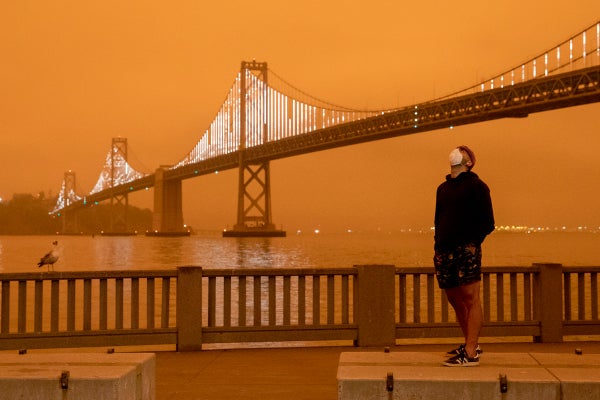As climate change intensifies summer after summer, millions of people around the world are finding themselves shrouded in toxic wildfire smoke, including those in North America, Russia and the Mediterranean just this past month.
I’m from Australia, where our devastating 2019–2020 bushfires and smoke caught the world’s attention.
Wildfire smoke is bad for our health. It is also really distressing, but we don’t talk about that as much.
On supporting science journalism
If you're enjoying this article, consider supporting our award-winning journalism by subscribing. By purchasing a subscription you are helping to ensure the future of impactful stories about the discoveries and ideas shaping our world today.
During Australia’s Black Summer, choking on smoke for about three months, I found it impossible to think of anything but the unfolding crisis. But later, in the process of writing a book about how we feel and what we can do about climate change, I spent time thinking about that experience. What could the smoke be teaching us, if we were willing to listen and learn?
We often use the terms “atmosphere” or “climate” to refer to the mood of a situation. We use meteorological metaphors to describe affective states, such as feeling under the weather, right as rain or on cloud nine.
Such language suggests that we understand that human emotions are intimately related to the meteorological. Yet rarely do we pay attention to the ways we feel climate change.
But wildfire smoke exemplifies how affective climate change can be. For example, wildfire smoke is often referred to using emotional phrases such as “airpocalypse,” “air of dread” or “pall of depression.”
Through dwelling with the smoke and the terror it generates, we can think more carefully about the ways we experience climate change, how we are entangled with it, and crucially, why and how we need to respond to it.
We often think of climate change impacts as far away, separate from or external to our bodies, because science typically uses global representations and statistical information. But wildfire smoke permeates and pollutes our bodies, and indeed, crosses many other boundaries: it’s almost impossible to keep out of buildings; it drifts from rural areas into megacities; and it crosses state and national borders with ease. Of course, some borders are more permeable, and some bodies more vulnerable to the smoke. Insulation from climate change is not equally accessible to all.
Through its ability to infiltrate and become part of our very being, wildfire smoke is closer in nature to the air pollution we normally think of as the causes of climate change: toxic air from fossil fuel extraction and combustion sites.
Wildfire smoke is both an impact and a cause of climate change. It illustrates the cascading nature of climate change impacts and the self-reinforcing feedback loops that can, and may, lead to the planet warming itself independent of human actions.
Specifically, it demonstrates cascades of combustion and asphyxiation. Intensified through the climate-changing combustion of fossil fuels, wildfire smoke is the not-fully-burned remains of forests and their inhabitants, many of whom will have died of suffocation before being burned. It then traverses the planet and inhibits the breath of those far from the fires. And as a source of further greenhouse gas emissions that will further heat the planet, creating more heat waves and wildfires, it decreases the breathability, and increases the flammability, of the planet as a whole in the long term.
Reading this, watching the news, seeing photos on social media and/or breathing in the smoke might be making you feel nauseous, dizzy or distressed. As such, the smoke also demonstrates that we do not feel things ‘about’ climate change. Rather, climate is an inherently felt phenomenon.
Temperature, atmospheric pressure, and precipitation are all things we can experience through our bodies, and that’s why they matter. The processes through which we experience and feel climate, and climate change, are often more convoluted and complex than those through which we feel the weather. Nevertheless, as wildfire smoke teaches us, climate change is visceral, palpable and sensible.
In sum, through our red eyes, inflamed throats, itchy noses and raspy lungs, the smoke reminds us that we can and do feel violence inflicted on the atmosphere in our own bodies, as this violence is also inflicted, in some ways, on ourselves.
Of course, we can reflect on all of this, but the learning will only matter if we do something in response, together. Wildfire smoke can also create political atmospheres, ones that might spark change, if people’s energy can be harnessed. In a world already exhausted from the pandemic, this may be difficult.
For this to happen, we have to talk about how the smoke, and climate change more generally, makes us feel. There is a crucial role for people to facilitate conversations in communities—all kinds of them—about this.
Climate change engagement research is increasingly showing that locally relevant examples of climate impacts can help the issue feel meaningful for people. And while concern about such impacts can inspire action, people need support to work out how best to respond, both in terms of navigating their feelings and engaging in collective action.
There are resources out there to support people to have such conversations. If/when safe to do so, I encourage you to talk about how you feel, physiologically and emotionally, about the smoke and climate change, with friends, family, and community, and then to explore the question of what we are going to do about it.
This is an opinion and analysis article; the views expressed by the author or authors are not necessarily those of Scientific American.
